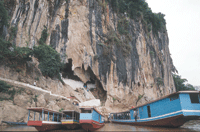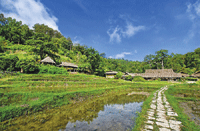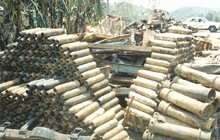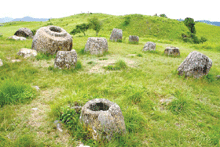In the second leg of his journey, Yoginder Sikand reports from northern Laos where evidence of the deep-rooted Hindu influence on Laotian Buddhism is reflected in scenes from the Ramayana on temple walls. Moreover he stumbles across incriminating evidence of America’s secret war of the 1960s in Laos, when it was the world’s most heavily bombed country
The narrow road from Vang Vieng to Luang Prabang in northern Laos winds through high altitude and densely forested mountains, whose summits are hidden in thick blankets of cloud. Much of this area is virgin forest, occasionally interrupted by emerald paddy fields neatly laid out in narrow valleys, bordered with rows of banana, papaya and ancient teaks, from whose trunks orchids bloom in dazzling hues.
 In terms of visitor footfalls, Luang Prabang is Laos’ premier tourist destination and one of the country’s oldest living cities. Formerly known as Muang Sa, its history goes back almost 1,500 years, and for some centuries it was the administrative capital of ancient Lao kings. When the French conquered Laos in the 19th century, the town’s mayor was appointed the nominal ruler of the entire country, although actual power shifted to Vientiane, which is currently the country’s capital.
In terms of visitor footfalls, Luang Prabang is Laos’ premier tourist destination and one of the country’s oldest living cities. Formerly known as Muang Sa, its history goes back almost 1,500 years, and for some centuries it was the administrative capital of ancient Lao kings. When the French conquered Laos in the 19th century, the town’s mayor was appointed the nominal ruler of the entire country, although actual power shifted to Vientiane, which is currently the country’s capital.
Luang Prabang (pop. 100,000) retains much of its unhurried, old-world charm. In the town centre is the former colonial quarter, with cobbled streets and French-style bungalows strung out on the banks of the meandering River Mekong. Many of the houses here have been converted into chic handicrafts boutiques and restaurants, which cater to a growing stream of foreign tourists as this hitherto hermetically-sealed communist-ruled country begins to open up to the outside world.
Every evening, this quarter morphs into a colourful, chaotic, street market. Village women from the mountains, dressed in conical straw hats and hand-woven sarongs, set up makeshift stalls on pavements selling touristy bric-a-brac — Buddhist icons and water colour paintings, Chinese porcelain urns and giant paper lanterns, buffalo horn opium pipes, turtle shell ashtrays and jewellery boxes, bamboo baskets, medicinal herbs and ferns, fierce clay masks, and bottles containing preserved snakes and scorpions. Vigorous bargaining is expected, and is usually a friendly affair that ends with the price being reduced to a fourth or even less of the first quote. Wheel carts display amazing local food: fish fresh from the Mekong, glass noodles served with crunchy, spiced vegetables, and for the more adventurous, live turtles and frogs, fermented swallows and deep-fried hornets and termites coated in honey are on offer.
As with the rest of this tiny country (pop. 6.5 million) wedged between Thailand and Vietnam in the Indo-China peninsula, the major tourist attractions of Luang Prabang are the wats or Buddhist monasteries. The town boasts almost two dozen wats, each a meticulous work of art. The pick of them all are the Wat Visoun and the Wat Mai, whose inner walls are generously embellished with finely executed frescoes depicting scenes from the Jataka Tales, recounting the many lives of Gautam Siddharth until he attained enlightenment in 5th century BC and transformed into The Buddha, liberated from the cycle of birth and death.
Adorning the outer walls of several other wats in Luang Prabang are motifs that are testimony to the deep-rooted Hindu influence on Laotian Buddhism — frescos of Hindu deities and scenes from the Ramayana, or ‘Rama Kien’ as it is locally known. The temple priests are kind and courteous, and welcome visitors to join them for morning prayers, after they return from their rounds with bowls containing offerings of food provided by the devout on which they subsist. A gong is sounded and they gather on the floor before an enormous Buddha image, chanting Pali mantras in a low drone, intoning and invoking the Buddha’s blessing.
 A rough and ready way to explore the environs of Luang Prabang is on boats which ply the Mekong. Country craft as well as mechanised launches travel to the far south of the country, connecting destinations that would be inaccessible, given Laos’ poorly developed road network. A popular two hour boat trip from Luang Prabang takes visitors to the stupendous limestone caves of Pak Ou. In the dark recesses of these caves some four thousand Buddha statues of varying sizes and poses lie hidden, most of them several centuries old. Patently poor village women entice tourists with chirping birds and giant-sized butterflies trapped in cane baskets, promising religious merit for buying the hapless creatures their freedom.
A rough and ready way to explore the environs of Luang Prabang is on boats which ply the Mekong. Country craft as well as mechanised launches travel to the far south of the country, connecting destinations that would be inaccessible, given Laos’ poorly developed road network. A popular two hour boat trip from Luang Prabang takes visitors to the stupendous limestone caves of Pak Ou. In the dark recesses of these caves some four thousand Buddha statues of varying sizes and poses lie hidden, most of them several centuries old. Patently poor village women entice tourists with chirping birds and giant-sized butterflies trapped in cane baskets, promising religious merit for buying the hapless creatures their freedom.
Young boys swing into the river from rope-like aerial roots that grow out from towering trees arching over river banks. Men stand neck-deep in water and set their fishing traps, or crouch patiently on wooden canoes armed with harpoons ready to attack unsuspecting fish and turtles. Old men and women gaze lazily into space, squatting on the verandahs of bamboo huts built on tall stilts. They attract attention by offering tourists country-rice beer, brewed in huge clay vats.
I had been in laos for ten days and my visa, valid for just a fortnight, was fast running out. I decided to head back to Vientiane, and then return to Bangkok. But for the return I chose a different route from the one I had taken on my way to Luang Prabang in the north. Braving a ten hour journey inside a rickety country bus plying a narrow mountain road riddled with giant craters, I headed south-east to the town of Phonsavan in the Xien Khouang province, on the Laos-Vietnam border. Far off the beaten tourist track, this area was badly scarred by the American bombing of Laos in the late 1960s at the height of America’s war in Vietnam, which led to the super-power’s humiliating defeat and retreat from the Indo-China peninsula in 1975.
 The mountainous region which connects Luang Prabang to Phonsavan is inhabited largely by Hmong tribals, the largest and most socio-economically disadvantaged minority in Laos. In contrast to Buddhist Lao, the Hmong are mainly animists, who worship a host of spirits, nature gods and their own ancestors. They began settling in the mountains of Laos in the 18th century, trickling in from southern China. The great majority of them own small farms on which they practice traditional slash-and-burn agriculture.
The mountainous region which connects Luang Prabang to Phonsavan is inhabited largely by Hmong tribals, the largest and most socio-economically disadvantaged minority in Laos. In contrast to Buddhist Lao, the Hmong are mainly animists, who worship a host of spirits, nature gods and their own ancestors. They began settling in the mountains of Laos in the 18th century, trickling in from southern China. The great majority of them own small farms on which they practice traditional slash-and-burn agriculture.
Travelling with me on the bus to Phonsavan was Muang, a Hmong college student who knew a smattering of English. From him I learned that there are hardly any schools in the Xien Khouang province. That, he said, was hardly surprising, given that the total number of primary schools in the whole of Laos is no more than 200, and not even one village in the entire country has a secondary school. In most cases, he said, three or four villages share a school, each run by a poorly-paid teacher. “We are communist in theory, but capitalist in practice,” he said. “Communist party bosses enjoy great privileges which are not for the masses.” Even the few school buildings and water tanks we passed by, were handouts from Japanese and Western NGOs, pointed out Muang.
The bus drove into Phonsavan just as darkness fell. While getting off, I heard the strains of Tamil music blaring from a shack near the entrance of the bus stand. Lifting a heavily food-stained curtain, I peered into the dimly lit Nisha Indian Food House, bare but for a table and three plastic chairs. There was a picture of the Taj Mahal on one wall, and posters of scantily-clad Bollywood actresses on the other. An elderly gent, dressed in a lungi and white cap, was clearing the dishes. “You Indian?” he asked as I entered, and no sooner had I answered in the affirmative than he gave me a disarmingly warm welcome, thumping me on the back like a long-lost friend.
Ali is a Tamil Muslim from Pondicherry who migrated to Laos more than half a century ago, when both territories were under French rule. He started off as a security guard at the house of a wealthy merchant in Vientiane and, several years later, with the rapidly growing trade between China and Vietnam, set up his eatery in the border town, offering Indian cuisine to visiting traders. He rattled off a dozen Indian dishes that he claimed he specialised in, but had only dal and rotis on the menu that night. I cheerfully settled for that, my first Indian meal in over a fortnight, a welcome change from noodle soup that had been my staple in Laos.
I checked into an inn run by a Chinese family. Standing like sentinels at the entrance were two massive metal objects shaped like rockets. Inside, scattered around the lobby, were dozens of bomb shells, cannon balls, hundreds of bullet shells strung together like necklaces, a couple of dented helmets and a rusted gun on a tripod. “These are remnants left behind by the Americans in their undeclared and secret war against the North Vietnamese-backed communist Pathet Lao movement,” explained Mr. Lee, the owner of the inn. Laos, he added, has the dubious distinction of being the most heavily bombed country in the world.
 The extent of the brutal bombing of this backward, agricultural society by the American air force gripped me the next morning, when I visited the offices of a local NGO that is still defusing mines dropped in the region by American airplanes over 40 years ago. To this day, they kill and maim hundreds of people, mainly peasants tilling their fields or desperately poor villagers scouting for scrap metal to sell for a pittance, or to use for making utensils and farm implements. The exhibits in the small museum that the Mines Advisory Group (MAG) maintains, graphically recreate the horrors of the American bombing of Laos in the 1960s, that killed over 100,000 people.
The extent of the brutal bombing of this backward, agricultural society by the American air force gripped me the next morning, when I visited the offices of a local NGO that is still defusing mines dropped in the region by American airplanes over 40 years ago. To this day, they kill and maim hundreds of people, mainly peasants tilling their fields or desperately poor villagers scouting for scrap metal to sell for a pittance, or to use for making utensils and farm implements. The exhibits in the small museum that the Mines Advisory Group (MAG) maintains, graphically recreate the horrors of the American bombing of Laos in the 1960s, that killed over 100,000 people.
In addition to using deadly nerve gas and chemical weapons, the US Air Force dropped over 3 million tonnes of bombs on Laos between 1960 and 1975, mainly in this part of the country, with American planes flying more than 500,000 sorties, explains a brochure published by the NGO. Almost a third of these bombs didn’t detonate and are still a threat to the public. The bombing runs had almost completely destroyed Phonsavan, which was entirely rebuilt two decades ago with generous Chinese assistance. According to a spokesperson of MAG, the US government is yet to issue an apology to Laos, and has given almost no help to defuse the thousands of live cluster bombs that still litter the countryside.
 An hour’s journey by road from Phonsavan takes visitors to one of Laos’ most famous historical sites, the Plain of Jars. Here over 3,000 monumental stone jars, some three metres tall are scattered across a 40 sq. km area. Dating back to 500 BC, they still baffle archaeo-logists, who haven’t been able to determine what they were used for. There’s a theory that they were ancient funerary urns; others believe they were used for religious rituals, and yet others surmise that they served as vats for preparing rice wine or storing grain. There are more than four hundred such sites across the Plain of Jars, and similar mysterious structures have been found in the long stretch that cuts across Laos and Thailand into northern Burma and right into the Cachar Hills of north-east India. Archaeologists believe a single trade route passed through a vast swathe of territory inhabited by ethnically related peoples.
An hour’s journey by road from Phonsavan takes visitors to one of Laos’ most famous historical sites, the Plain of Jars. Here over 3,000 monumental stone jars, some three metres tall are scattered across a 40 sq. km area. Dating back to 500 BC, they still baffle archaeo-logists, who haven’t been able to determine what they were used for. There’s a theory that they were ancient funerary urns; others believe they were used for religious rituals, and yet others surmise that they served as vats for preparing rice wine or storing grain. There are more than four hundred such sites across the Plain of Jars, and similar mysterious structures have been found in the long stretch that cuts across Laos and Thailand into northern Burma and right into the Cachar Hills of north-east India. Archaeologists believe a single trade route passed through a vast swathe of territory inhabited by ethnically related peoples.
Brutal scars of America’s Indo-China war are starkly visible here. Two massive craters caused by bombs dropped by the US air force, and a maze of underground tunnels and caves used by communist forces resisting the Americans, that are now rapidly disappearing under encroaching forest. As in the rest of the province, the plain is still littered with unexploded mines and bombs, and visitors are forbidden to step off cleared beaten tracks. A skeletal shell of a tank lies half buried in the earth, its parts being hacked off and sold to scrap merchants.
 An eerie silence envelopes the Plain of Jars that receives few visitors, but the countryside beyond presents a picture postcard view of rustic placidity: grassy knolls that gently stretch into horizons dotted with straw-roofed wooden huts, alongside murmuring brooks. That beatific image travelled with me as the bus wound its way down the hills and I finally made my way back later that day to Thailand, exiting Laos on the day my visa expired.
An eerie silence envelopes the Plain of Jars that receives few visitors, but the countryside beyond presents a picture postcard view of rustic placidity: grassy knolls that gently stretch into horizons dotted with straw-roofed wooden huts, alongside murmuring brooks. That beatific image travelled with me as the bus wound its way down the hills and I finally made my way back later that day to Thailand, exiting Laos on the day my visa expired.
An overpowering sense of serendipity is, of course, just one side of Laos, which the visitor to the country cannot escape. There is a brutal counter image as well, which tourist brochures don’t advertise: the country’s gruelling poverty, its one-party communist junta, live legacies of a secret war, and now, Western cultural invasion with the advent of mass tourism. But somehow, all that fades when in vacant and pensive mood I remember the people and places of this brave country. The dominant visions are of quiet Hmong villages, virgin forest, the River Mekong gently bearing dug-out canoes on its expansive bosom, and of course, the fairy tale meadows of the Plain of Jars .